There are many animal species like insects, birds, bees who depend on a plant species to fulfill their need of nutrition, they live on the plant, these plants support other communities to live, are known as their host plant.
Let’s have a closer look at the host plant examples.
Common milkweed
Common milkweed or Asclepias syriaca is an angiosperm species belonging to the family Apocynaceae. It is a perennial forbs native to the Canada, USA of the Rocky mountain region. The plant bears highly fragrant, pinkish to purplish coloured nectariferous flowers in umbellate cymes. A plant is a host plant of more than 450 species including flies, beetles, ants, bees, wasps, and butterflies etc. The plant is mostly known as the host plant of monarch butterfly caterpillars (Danaus plexippus), red milkweed beetle (Tetraopes tetrophthalmus), the milkweed tussock caterpillar (Euchaetes egle),etc. They live and feed on the leaves of the tree.
Butterfly milkweed
Butterfly milkweed or A. tuberosa is an angiosperm species belonging to the family Apocynaceae. It is a perennial plant native to the eastern and south western North America. The plant bears yellow to orange coloured flowers at the time of summer to early autumn. Through the color and fragrant nectar it attracts several Lepidopteran species who act as pollinators and the larvae stages also feed on the leaves of the plant. A. tuberosa is a larval host plant of the queen and monarch butterflies, dogbane tiger moth, milkweed tussock moth, etc.
Swamp verbena
Swamp verbena or Verbena hastata is a perennial herbaceous plant, one of the most common host plant examples belonging to the family Verbenaceae. It is a native to the North American region. At the time of summer the plant bears blue to violet coloured flowers on it. Through the color and fragrance of the flowers the plant attracts multiple butterfly species and these are several as pollinators. The plant is especially a common larval host plant of buckeye butterflies.
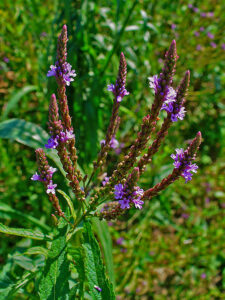
Swamp verbena from Wikimedia Commons
Little Bluestem Grass
Little bluestem grass or Schizachyrium scoparium is a perennial bunchgrass species belonging to the family Poaceae. It is native to some areas of the United States and northern Canada US border and northern Mexico. In May June it initiates flowering stalks and the blades become coppery orange in color. In winter it becomes more orangish-bronze in color. Schizachyrium scoparium is a common larval host of several Lepidopteran species such as cobweb skipper, common wood nymph, crossline skipper, Dakota skipper, dusted skipper, Leonard’s skipper, Ottoe skipper, swarthy skipper,etc.
Dill
Dill or Anethum graveolens is an annual herbaceous plant belonging to the family Apiaceae. It is native to the Eurasian region, one of the common host plant examples. The plant grows 40–60 cm long and bears white to yellow coloured small umbels. The umbrella flower, using its color and fragrance, attracts several pollinator species including insects, butterflies, moths, etc. It is a most common larval host plant of black swallowtails. The butterflies, attracted by its fragrance, come and collect nectar, lay eggs on it. After hatching the caterpillars live and feed on the leaves of the plant.
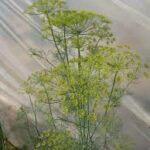
Dill from Wikimedia Commons
American Elm
American Elm or Ulmus americana is a deciduous hermaphrodite tree species belonging to the family Ulmaceae. It is native to the north eastern American regions. There are several species found under the genus Ulmus. The plant bears purple- brown colored small flowers. American Elm serves as a common larval host plant of several butterfly and moth species such as Polygonia comma, Polygonia interrogationis, Mourning Cloak (Nymphalis antiopa), Painted Lady (Vanessa cardui) and Red-spotted Purple (Limenitis arthemis astyanax), as well as such moths as the Columbian Silkmoth (Hyalophora columbia), the Banded Tussock Moth (Pale Tiger Moth) (Halysidota tessellaris, etc.
Willow
Willow or sallow or selix is a group of plant species belonging to the family Salicaceae. There are more than around 400 species found under the genus. It is native to the Northern hemisphere, one of the most common host plant examples. It is a dioecious plant which means male and female flowers generally produce catkins in different plants. The tree is famous for producing a modest amount of nectar which attracts different honey bee and butterfly species. It is the most common larval host plant of different Lepidopterans such as Viceroy Butterfly, Lorquin Admiral Butterfly, Eastern Tiger Swallowtail, Mourning Cloak Butterfly, Western Tiger Swallowtail, Dreamy Duskywing, etc.
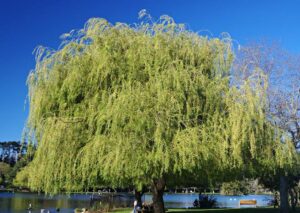
Willow from Wikimedia Commons
Oak
Oak or Quercus is a group of plants belonging to the family Fagaceae. There are more than 500 species found under this genus. Oak is a monoecious tree meaning both male and female flowers are produced in the same plant. The flowers of this plant are generally catkins. Oak is an important keystone species which positively affects its surrounding eco diversity. It is also a common host plant to different butterfly, moth and bird species including red-spotted purple, duskywings, banded hairstreak, white M hairstreak, clymene moth, imperial moth, cecropia moth, rosy maple moth, greater spotted (Dendrocopos major) bird, lesser spotted (Dryobates minor) birds and green woodpecker (Picus viridis), etc.
Cherry
Cherry is a plant species belonging to the genus Prunus, one of the most common host plant examples. It is serves as larval host plant of different butterfly and moth species such as Eastern Tiger Swallowtail butterfly, Cherry Gall Azure, Promethea Moth, Small-eyed Sphinx Moth, Wild Cherry Sphinx Moth, Banded Tussock Moth, Columbia Silkmoth, Band-edged Prominent, Spotted Apatelodes, etc.
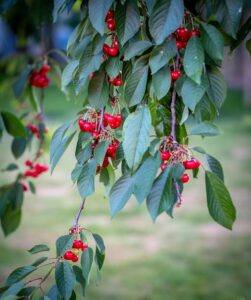
Cherry plant from Pixabay.com
Sugarberry
Sugarberry or hackberry or Celtis laevigata is a tree species belonging to the family Cannabaceae. It is a medium sized tree species native to the North American regions. It is an angiosperm tree, one of the most common host plant examples. There are several different butterfly species attracted by the plant and select it as the larval host plant including hackberry emperor (Asterocampa celtis), tawny emperor (Asterocampa clyton), question mark (Polygonia interrogationis), American snout butterflies (Libytheana carinenta and L. carinata), mourning cloak (Nymphalis antiopa), comma, etc.
Indian Paintbrush
Castilleja or Indian Paintbrush is a perennial herbaceous flowering plant species belonging to the family Orobanchaceae. There are more than 200 species found under the genus. Indian paintbrush is one of the most common host plant examples. The plant is a common larval host plant to different lepidopteran species such as Schinia cupes and Schinia pulchripennis and checkerspot butterflies, Euphydryas species.
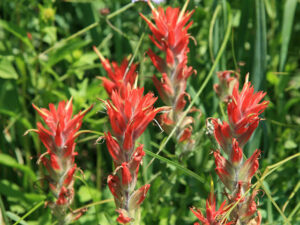
Indian paintbrush from Wikimedia Commons
Common Snowberry
Common Snowberry or Symphoricarpos albus is a flowering plant example belonging to the family Caprifoliaceae. It is a native plant to the north American regions. The plant bears small bell shaped flowers bright pink in color. The flower develops a berry like fruit in it. The Symphoricarpos albus serves a good food source for different herbaceous animal species like sheeps, cattles, bears, deers,etc. The plant is also a common larval host and food plant to several butterfly species such as Chalcedon Checkerspot Butterflies. Different bird species like towhees, thrushes, robins, grosbeaks, waxwings, insects, bees depend on this food plant and eat the leaves and berries.
American Wisteria
American Wisteria or Wisteria frutescens is a flowering plant belonging to the family Fabaceae. It is one of the most common host plant examples. It is a woody, perennial, vine which grows up to 15m long. The plant bears purplish-white coloured flowers which attracts pollinators. The plant is a very common host plant to different lepidopteran species including Horace’s Duskywing, Silver-spotted Skipper, long tailed skipper, marine blue, zarucco duskywing, etc.
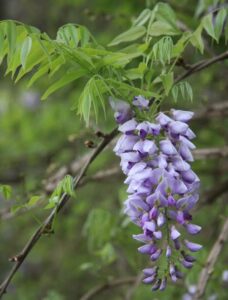
American Wisteria from Wikimedia Commons
Viburnum
Viburnum is a flowering plant genus belonging to the family Adoxaceae. There are more than 150–175 species found under this genus. The tree is a deciduous or evergreen plant that bears colorful flowers in the flowering season. The flowers attract different bee species, butterfly species which are sarve as pollinators and cause pollination. According to the species variety of the viburnum several insect species select the tree as their common larval host plant such as Spring Azure butterfly (Celastrina ladon), Hummingbird Clearing Moth (Hemaris thysbe), etc.
Cow Vetch
Cow Vetch or Vicia cracca perennial flowering herbaceous plant belongs to the grass family Fabaceae. Cow Vetch is one of the most common host plant examples. At the time of flowering the plant produces pea-flower shaped purple to violet flowers. These flowers attract pollinators. Among several other butterflies and bees, bumblebees are the most common pollinators to come. Several butterfly species come and female adults lay eggs on it. After hatching the plant fulfills all the food needs of the larvae or caterpillar. Cow Vetch is the most common larval host plant to Wild Indigo Duskywing, Orange Sulphur Butterfly, Gray Hairstreak, Eastern Tailed-Blue, Crossline Skipper, etc.
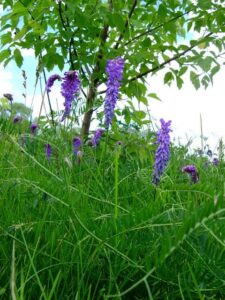
Cow Vetch from Wikimedia Commons
As a whole we can say that host plants are one of the most important parts that helps to maintain an eco diversity and helps to grow another living community around them. Here we see that different types of plant species including herbs, vines, huge trees, wild flowering plants all contribute to maintaining an ecosystem and serve as a host plant. Hope this article on common host plant examples will be helpful to you.
Also Read:
- Brewer s yeast
- Polygenic inheritance example
- Prokaryotic chromosome structure
- Purine fundamental structure
- Are bacteria herbivores
- Do protists have a cell wall
- Antiparallel dna strands 2
- Is fungi abiotic
- Centipede characteristics
- Do prokaryotes have enzymes

Hello, I am Piyali Das, pursuing my Post Graduation in Zoology from Calcutta University. I am very passionate on Academic Article writing. My aim is to explain complex things in simple way through my writings for the readers.